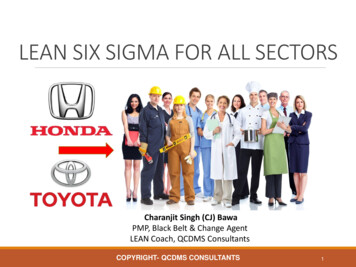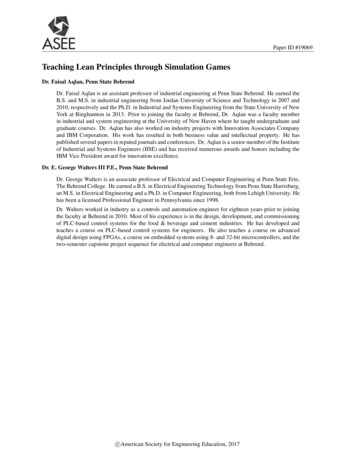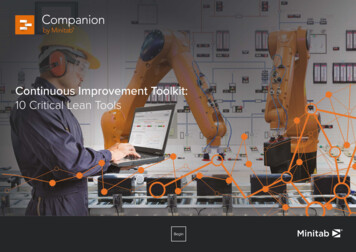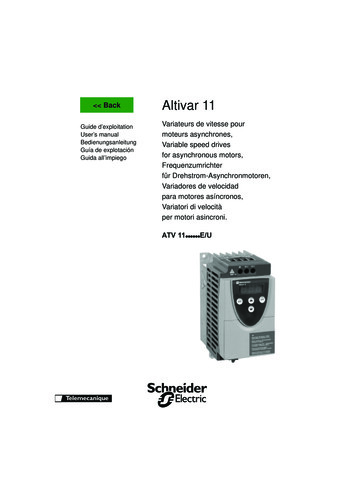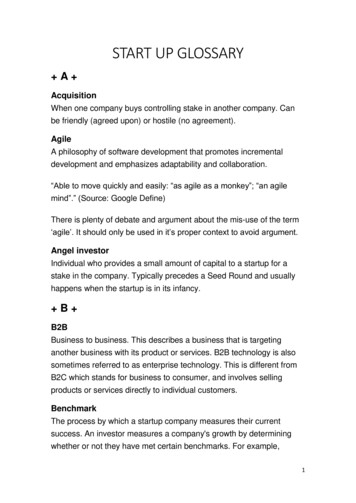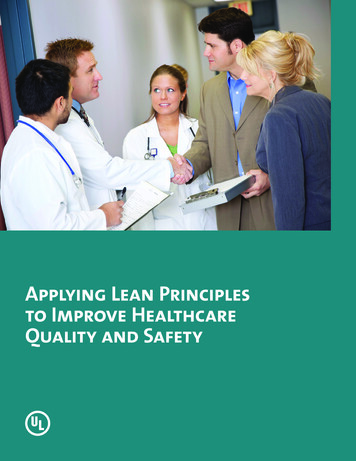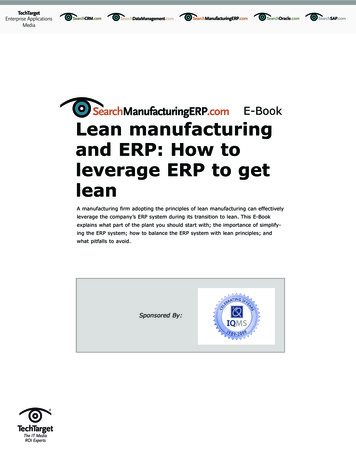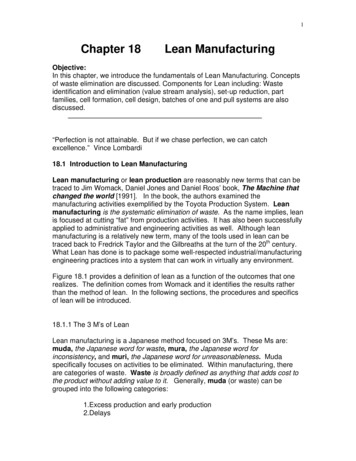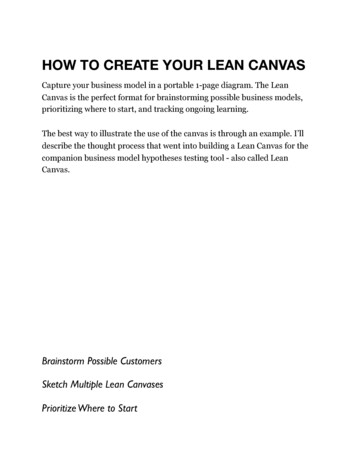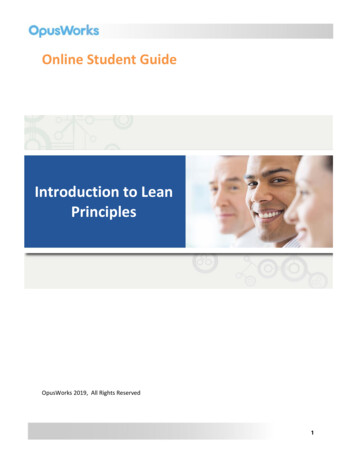
Transcription
Online Student GuideIntroduction to LeanPrinciplesOpusWorks 2019, All Rights Reserved1
Table of ContentsLEARNING OBJECTIVES . 4INTRODUCTION . 4HEADLINES . 4WHY LEAN? . 4WHAT IS LEAN? . 5SIX SIGMA AND LEAN IN TANDEM . 5WHY LEAN? . 5HISTORY OF LEAN - TAIICHI OHNO . 6HISTORY OF LEAN - JAMES WOMACK . 6PRINCIPLES OF LEAN . 6DEFINE CUSTOMER VALUE . 7MAP THE VALUE STREAM . 7VALUE STREAM MAPS . 8KAIZEN . 9LEAN FOCUS . 9LEAN THINKING . 10FLOW IN THE VALUE STREAM . 10ENABLE FLOW . 11EIGHT LEAN TOOLS . 11STANDARD WORK . 11POKA-YOKE . 12QUALITY AT THE SOURCE . 125S . 12CONTINUOUS/ONE-PIECE FLOW. 13CHANGEOVER/SETUP . 13EIGHT WASTES . 14TOTAL PRODUCTIVE MAINTENANCE . 14VISUAL MANAGEMENT AND VISUAL CONTROLS . 14DEVELOP PULL. 15PULL SYSTEM . 15LEVEL PRODUCTION DEMAND . 16CONTINUOUSLY IMPROVE . 16WHY LEAN IMPLEMENTATION?. 16VALUE ADDING & NON-VALUE ADDING ACTIVITIES . 17LEAN BENEFITS . 17LEAN FOR SERVICE PROVIDERS . 18LEAN IMPLEMENTATION . 182
2019 by OpusWorks. All rights reserved. August, 2019Terms of UseThis guide can only be used by those with a paid license to the corresponding course in the e-Learningcurriculum produced and distributed by OpusWorks. No part of this Student Guide may be altered,reproduced, stored, or transmitted in any form by any means without the prior written permission ofOpusWorks.TrademarksAll terms mentioned in this guide that are known to be trademarks or service marks have beenappropriately capitalized.CommentsPlease address any questions or comments to your distributor or to OpusWorks atinfo@OpusWorks.com.3
Learning ObjectivesUpon completion of this course, student will be able to: Define Lean and discuss its importance, benefits, and objectivesDescribe Lean tools, methodologies, and levels of deploymentIdentify the roles and responsibilities of the Lean implementation teamDiscuss how these roles can be integrated into an organizationIntroductionHeadlinesAlmost daily, the news headlines bring us stories ofmergers, acquisitions, Chapter 11 filings, major marketshifts, and other business woes. Mixed with the bad news,however, are success stories of organizations that are notonly surviving, but thriving. As we continue, let’s considerthe key ingredients for business survival, and beyond that,continued business success.Why Lean?In one way or another, everyone is a customer. Typically, customers choose to do business withcompanies that are committed to understanding and satisfying their needs. When they are not pleasedby the company, customers look for a replacement. Customer focus with a commitment to provide adesired product or service is very important to anorganization’s success. Responsiveness, the ability tounderstand what the customer desires and toprovide it quickly, is fundamental to anorganization’s success.However, because many companies have similarcapabilities, customer focus and responsivenessalone cannot guarantee success. To be successful, anorganization must find ways to differentiate itselffrom the competition. Products and services must be provided efficiently, making good use of resources,and without waste. Finally, organizations are rarely successful over time without a commitment tocontinual improvement; stagnation does not bode well. What is acceptable today will be “old news”tomorrow. An organization's leaders must have the vision and commitment to drive long term success.4
What is Lean?Now that you have a basic understanding ofwhat it takes for an organization to besuccessful, let’s see how Lean fits in.The core idea of Lean is to maximizecustomer value while minimizing waste.In other words, its focus is to create morevalue for the customer, using fewerresources, shorter cycle times, faster processtimes, and higher quality.Six Sigma and Lean in TandemWhen organizations combine Lean with Six Sigma, the results are powerful. Used in tandem, Six Sigmaand Lean endow organizations with a principle and structured culture of relentless waste reduction,which is empowered even further by the advanced techniques of process variability analysis andreduction.Six Sigma principles are problemfocused and stem from thefundamental belief that processvariation is waste. Lean, on the otherhand, is focused on process flow;it views any activity that does notadd value as waste. Whereas Six Sigmauses statistics to understand variation, Leanuses visuals (such as process mapping, flowcharting, and Value Stream Mapping) tounderstand the process flow.Why Lean?Accurate project selection sets a strong foundationfor the successful implementation of Lean. The teammust identify improvement projects that align withthe organization’s strategic improvement initiatives.Furthermore, the selected projects must be basedupon those metrics that shape the organization’sbusiness strategy. By focusing on improvements tocore processes in order to meet customerrequirements, Lean becomes the framework fordeploying the business strategy.5
History of Lean - Taiichi OhnoLet’s take a look back at the history of Lean. As with allvaluable innovations, Lean was born from a need.In the late 1940s and early ‘50s, following World War II,Toyota Loom Company wanted to move into automotivemanufacturing. Taiichi Ohno, along with Eiji Toyoda andShigeo Shingo, worked to improve Toyota’s manufacturingoperations. The three men are credited as being the first to consider the central role of inventory andwork in process, which is a key Lean principle today. With additional incentive from the oil crisis of the1970s, Ohno is further credited with developing the Toyota Production System, a term now usedinterchangeably with Lean manufacturing.History of Lean - James WomackWhile Ohno is credited with developing Lean, James Womack’s use of the term “Lean Manufacturing” inhis book, The Machine that Changed the World,highlighted Lean principles and benefits.Although Lean’s roots are in manufacturing, it hasequal application to non-manufacturing operations. In1996, Womack joined Daniel T. Jones to write LeanThinking, which further explored Lean’s applicationand benefits for manufacturing and nonmanufacturing processes.Principles of LeanNow that we have discussed what it takes for an organization to achieve long-term success, and howLean fits in, let’s look at how Lean works. Lean is guided by five key principles, as follows:--Define Customer Value. In Lean, value is specified from the standpoint of the end customer.Map the Value Stream. Value Stream Mapping is thekey to identifying waste in the process, andeliminating, whenever possible, those steps that donot create value.Enable Flow. When value-creating steps occur in tightsequence, the product will flow smoothly through theprocess.Develop Pull. When Continuous Flow is not possible,customers Pull value from the next upstream activity.Continuously Improve. As value is specified, ValueStreams are identified, wasted steps are removed, and Flow and Pull are introduced. Once thisprocess is completed, it begins again, and the steps are repeated. The improvement processcontinues until a state of perfection is reached, in which perfect value is created with no waste.6
Define Customer ValueLet’s take a closer look at each of the five Lean principles.The first key principle of Lean is to define customer value. Only by understanding what the customervalues, can an organization effectively deliver it. To be successful, an organization mustnot only give the customer what it needs, but it must do so at the rate it’s needed,when it’s needed, in the quantity needed, and of the quality needed. Once anorganization has defined value from the customer perspective, it seeks to deliverthat value by reducing waste, improving quality, reducing lead time, and reducingcosts.It is important to remember that, in addition to the external customer, thecustomer is often the next process or operation in the Value Stream.Map the Value StreamOnce an organization has defined customer value, the next step is toMap the Value Stream. The Value Stream consists of the series ofprocess steps that create customer value. That is, all theactivities and events that happen in order to get theproduct or service to the customer. To map the ValueStream, an organization analyzes this stream ofprocess steps.To get an accurate picture of its Value Stream, a Leanorganization looks at its process from the perspective of the material flow (from supplier to customer)and information flow (from customer to supplier). This flow of materials and information supports theValue Stream activities. Value Stream Maps are used to capture and specify the activities, information,timing, and events that occur in the Value Stream. First, the Lean team will create a Current State ValueStream Map, which defines the Value Stream in its current state to see how the entire process workstogether. From there, it creates a Future State Value Stream Map to identify waste and improvementactivities that will lead to an ideal future state.There are three types of value in a process. “ValueAdding” activities are the ones that transformmaterial or information into customerrequirements. Put simply, these are the activitiesthat occur in a process for which the customer iswilling to pay. “Non-Value Adding (required)”activities are those that do not add valuefrom the customer’s perspective, but arenecessary to operate the business. The thirdcategory, “Non-Value Adding” activities, arethe ones that do not add value in any way;they are waste. Once the Lean teamidentifies Non-Value Adding activities, it7
should begin taking actions to completelyeliminate them, or to minimize them asmuch as possible.When assessing the Value Stream, the teamfocuses on time, flow, and Value-AddedAnalysis. It creates a Value Stream Map foreach major process area. When mappingthe process areas, the team looks to see how much time each activity is currently taking; which activitiesare Value Adding versus Non-Value Adding; and how it can improve the flow of the process to reducethe time required to produce the product.Value Stream MapsValue Stream Mapping allows a delivery system for products or services to be viewed graphically, as acontinuous flow of processes or activities that add value. Value Stream Mapping forms a basis for Leanimplementation by initially focusing the teamon the current state of a selected stream.Once the current state has been clearlymapped, it then serves as a basis forimprovement to a future state.A Value Stream Map allows teams to seethe entire process flow of both materialsand information. This, in turn, enablesthem to identify processcommunications and linkages.Importantly, teams can use Value Stream Maps to calculate the Value-Added Timeand compare it to the Total Cycle Time. The Value Stream Map shown here, for example, showscommunication from customers to production control, which is then passed to suppliers and productionsupervision. Supplies are received on a weekly basis, and product is pushed through the five operationsrequired to ready it for shipment. Operation specifics are described in terms of Cycle Time (C/T),Changeover (C/O), Yield, and Uptime. The amount of time a product spends from start to finish,including waiting between operations, istotaled and communicated as Total CycleTime. This is compared with the total timethat is actually spent adding value to theproduct. The difference between thesenumbers, combined with the customerdemand, forms the basis for improvementand development of the Future State Map,which makes Lean possible. Value StreamMaps allow teams to identify problemareas, bottlenecks, excess inventory, wasteand its sources, and potential safety orequipment issues.8
KaizenKaizen is a Japanese word meaning "improvement” or "changefor the better”.A Kaizen Event (also commonly called a Kaizen Burst) is a shortduration, highly-focused improvement activity during which adedicated cross-functional team designs and implementsimprovements to a defined work area or process.Kaizen Events are designed to bring rapid results; the Event itself is typically carried out within three tofive days. These Events can bring substantial benefits to an organization by targeting effort andresources to fix a business crucial issue. For example, a team may wish to focus a Kaizen Event on aproduct quality issue or excessive lead time. Launching such a Kaizen Event lets the organization knowthat an issue exists, and it has a plan to resolve it.Typical Kaizen Events focus on issues such as cycle time reduction, excessive changeover time, qualitydefects, excessive scrap, cleanliness and organization, excessive inventory, and process flowimprovements.Lean FocusBefore we discuss the next Lean principle, Enable Flow, let’s set the stage Conventional organizations are formed around functional and departmental thinking. Each departmenthas its own set of targets to achieve, and performance is measured against their key performanceindicators. For example, an organization’s sales department might measure performance based on itsability to win new business, to provide the customerwith what they want, when they want it, and to sell itat a profitable price. The ordering department, on theother hand, might assess its ability to keep costs downand inventory at a minimum.Meanwhile, for the operations department,performance might be based on its ability to achievetarget efficiency, quality, and output. The problemwith this type of functional and departmental thinking is that when it’s measured at the organizationallevel, key performance indicators from various departments are often conflicting.In almost all organizations, work gets done in processes that cross organizational boundaries. With thisin mind, Lean focuses on understanding the entire flow, across all process steps. It seeks to optimize thesystem based on the work, rather than on individual departmental metrics.When each functional organization is optimized to run at peak performance against their performanceindicators, without taking the other organization’s needs and performance metrics into consideration.This is referred to as “sub-optimization.” Typically, this results in a sub optimized process.9
To be most successful, Lean organizations must keep their focus on the customer, balancing eachprocess to meet customer quality, cost, and delivery goals. Some functions may need to operate at lessthan ideal in order for the entire Value Stream to operate at optimal performance.Lean ThinkingLean thinking changes the focus of management. Rather than striving to optimize separate functions,technologies, and assets, Lean focuses onoptimizing the flow of products and servicesthrough the entire Value Stream, from thesuppliers through to the customers.Creating a flow through the Value Streamrequires thinking differently aboutdepartmental boundaries, organizations,performance metrics or any other barrierswithin an enterprise.Flow in the Value StreamWhen you turn on your kitchen faucet, you expect to have a consistent flow of clean, safe, drinkingwater. In Lean, this same concept of flow applies to the Value Stream. Consider what would need tohappen in order for a product or service to flow consistently through the value adding process, from thesupplier to the customer. In a production environment, achieving this type of flow would requireminimum product or service variation, no excess inventory, and no equipment breakdowns.Earlier in this module, you learned that true responsiveness to internal and external customer needs isachieved by giving the customer “what is needed, when it’s needed, and without issues.” Another wordfor this is “Value.”The Lean concepts Just In Time (or JIT) andContinuous Flow focus on this issue ofresponsiveness by establishing operationsthat respond at the time of customerdemand. JIT and Continuous Flow arebased on workforce flexibility, notincreased inventory levels.10
Enable FlowThis brings us to the third key principle of Lean, Enable Flow.In this step, teams begin by eliminating sources of waste. To improve yield and reduce variation, theycan use Six Sigma projects and tools, such as documentation of Standard Work procedures andapplication of Poka Yoke processes. The team then implements visual instructions and controls toensure the improvements are maintained. Changeover reduction and Total Productive Maintenanceactivities are performed to increase resource availability and reduce equipment overloads anddowntime. The goal is to design processes that produce stable and predictable output, capable ofproducing within the determined cycle time.Continuous Flow can only be achieved when each process can keep up with customer demand, and theproduct is defect free. Flow can be improved by optimizing the physical location of operations, wherepossible, and removing Non-Value Adding steps. 5S can be used to organize and improve the efficiencyof work areas.Eight Lean ToolsStandard WorkWhile control plans address an entire process flow, standardizedwork practices deal with the more specific details of producing aproduct or service. They document optimized operations andimprovements, and serve to ensure these are carried outconsistently.The goal of Standard Work is effective use of people, materials,methods, and machines. It describes how a part or service isprocessed, and may be known as “work instructions.” StandardWork includes associate or equipment interactions, includingsafety, motion, and ergonomic studies.Benefits include quality product and satisfied customers; motivated associates,functioning in a safe environment; and increased productivity based on reduced variation.These benefits are greatest when standardized work practices are used in all operations,across the entire facility.11
Poka-YokePoka-Yoke is a Japanese term for an error-proofing procedure ordevice used to prevent a defect from occurring during production of aproduct or delivery of a service.Examples of Poka-Yoke include guide pins of different sizes; andshaping variations (such as the USB shown here); error detection andalarms, including automated shutdown when operations are out ofcontrol and producing defects; limit switches; counters; and checklists.Quality at the SourceInspection as a separate operation or step is not Value Added. Quality atthe Source, or Built-in-Quality, refers to inspections or checks andbalances that are performed as part of an operation—while the productor service is being produced, and not in a separate operation.Quality at the Source depends upon clearly defined customerrequirements (either the external customer or the next step in theprocess); specifications for distinguishing good from bad product; andguides for monitoring and adjusting to meet these requirements. Whenrequirements are not met, associates are empowered to “stop the line”in order to stop defects and to act to prevent them, or the machine stopsitself. Poka-Yokes are key to Quality at the Source.5SFive S methodology guides organizations to create and maintain an organized, clean, and safe workenvironment as a foundation for achieving Lean. It starts with basic housekeeping, but is much more asit becomes a way of doing business.The five steps or phases of this Japanese based process are: Sort, or Seiri, which focuses on keeping onlywhat is required; Store and Set in Place, or Seiton, which focuses on arranging and identifying items forease of use; Shine, or Seiso, which focuses on regular cleaning; Standardize, or Seiketsu, which focuseson eliminating causes, reducing variations, and making standards obvious; and Sustain, or Shitsuke,which focuses on ensuring everyone understands and sticks to the Five S methods put in place. Five Spaves the way for improvement.12
Continuous/One-Piece FlowIn Lean terms, the ideal flow is a continuous, one-piece flow of parts, information, or service which isdelivered uninterrupted to the next operation or customer. This results in minimal inventory orshortened or eliminated wait times for performing a process or delivering a service.Lean's focus is on: "what's needed, when needed." Continuous or one-piece flow supports Lean byfocusing on two things. First, on a cellular environment where everything needed to produce a part orservice is available. Second, the guidelines that nothing proceeds to the nextprocess until complete and correct. Continuous or one-piece flow results infewer errors, improved quality and higher overall efficiency as all requiredinformation, material, tools and equipment are in place and available. Itmay be more efficient for an operation to produce a batch, however,inventory may build and delivery to the customer may slowbecause parts or information waiting for the batch cannot addfurther value until the whole batch is completed. Whenflow is considered across the entire value stream, thenbatching, even where it seems to make sense for aparticular operation, may be inefficient. When machinesor operations are grouped to achieve an optimal processflow, we call this a Cellular Configuration. The goals of aCellular Configuration include lead time reduction, operatingcost reduction, increased labor flexibility, and increased laborutilization.Changeover/SetupSetup Reduction, Quick Change, and Single Minute Exchange of Dies (S.M.E.D.) focus on reduction ofsetup and changeover times. Setup or changeover time indicates the time elapsed from the unloadingor completion of the last good part of one run, to theproduction of the first good part of the next run.Setup Reduction, Quick Change, and S.M.E.D. support Leangoals and objectives through reduced costs, smaller lot sizes,and shorter lead times. Additional benefits include thefollowing: reduced inventory generated from overproduction,and related cash flow improvement; elimination of waste fromNon-Value Adding activities; improved facility capacity;increased flexibility and responsiveness; improved quality as lotsizes and lead times are reduced; and improved competitiveness.13
Eight WastesWaste exists in many forms, including Transportation, Inventory, Motion, Waiting, Overproduction,Over-Processing, Defects, and Skills (under-utilized human potential). An easy way to remember thetypes of waste is the acronym TIMWOODS. By reducing waste, an organization reduces costs andincreases flexibility.Total Productive MaintenanceFor Total Productive Maintenance (or TPM), team and shop floor associates work to maximize theeffectiveness of manufacturing equipment, with thegoal of preventing breakdowns and defects.TPM is based on the following four components:preventive maintenance, which focuses on proactivemaintenance to prevent breakdowns; correctivemaintenance, which focuses on equipmentimprovements or modifications to preventbreakdowns or make maintenance easier;maintenance prevention, which focuses onminimizing required maintenance based onequipment design or installation; and breakdown maintenance, which focuses on repairing breakdowns.Visual Management and Visual ControlsRemember the saying, “A picture is worth a thousand words."? Visual Management and Visual Controlsare based on that same simple philosophy.Visual Management incorporates Visual Controls andprocess layouts to make it easy for anyone in theproduction area to easily spot an abnormal orunusual situation.Visual Controls may be used to show the following:how to do a job, including standard, agreed-uponbest practices; where things are stored; how to use atool or device; required inventory levels;14
performance status; when help is needed; and potential hazards. Visual Controls help mistake-proof orerror-proof the operation.Develop PullThe next principle is Develop Pull.In reality, Continuous Flow is not always achievable throughout the entire Value Stream. For example,Continuous Flow is often obstructed when one of the processes in the Value Stream takes much longeror is less predictable than the others. When this happens, these processes cannot be connected directlywith the others in a Continuous Flow.Rather than attempting to schedule these operations using a traditional scheduling function, teamsallow these processes to be controlled by PullSystems. Pull Systems produce products, services,or items based upon actual customer requests,orders, or consumption.They provide an accurate indication of the type andquantity of product needed by downstreamprocesses. Rather than predicting the demand,they indicate the exact demand that exists.Sometimes, either product mix or cust
Principles of Lean Now that we have discussed what it takes for an organization to achieve long-term success, and how Lean fits in, lets look at how Lean works. Lean is guided by five key principles, as follows: - Define Customer Value. In Lean, va
